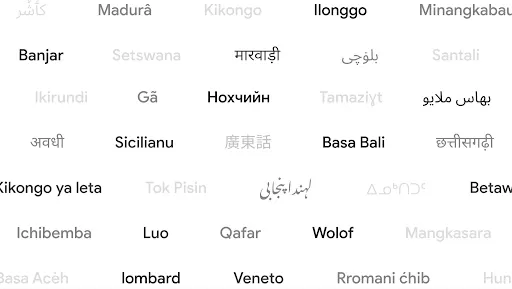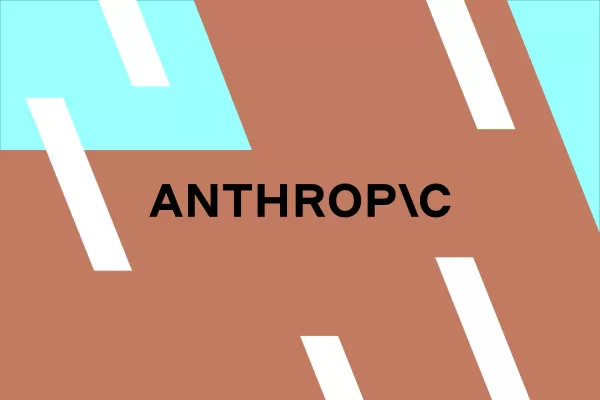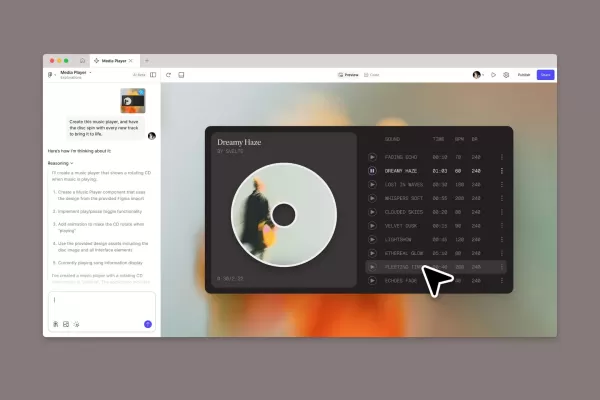Google Translate Adds 110 New Languages

Google Translate is all about breaking down language barriers and helping folks connect and understand the world better. We're always on the hunt for the latest tech to make this tool more accessible. Back in 2022, we added 24 new languages using Zero-Shot Machine Translation, where a machine learning model learns to translate into another language without ever seeing an example. Plus, we kicked off the 1,000 Languages Initiative, aiming to build AI models that support the 1,000 most spoken languages worldwide.
Now, we're using AI to expand the variety of languages we support even further. Thanks to our PaLM 2 large language model, we're rolling out 110 new languages to Google Translate, which is our biggest expansion yet.
Translation support for more than half a billion people
-------------------------------------------------------
From Cantonese to Qʼeqchiʼ, these new languages cover over 614 million speakers, opening up translations for about 8% of the world's population. Some are big world languages with over 100 million speakers, while others are spoken by small Indigenous communities. A few are even being actively revived despite having almost no native speakers left. About a quarter of these new languages are from Africa, marking our largest expansion of African languages yet, including Fon, Kikongo, Luo, Ga, Swati, Venda, and Wolof.
Here are some of the newly supported languages in Google Translate:
- Afar, a tonal language spoken in Djibouti, Eritrea, and Ethiopia, had the most volunteer community contributions of all the languages in this launch.
- Cantonese, long one of the most requested languages for Google Translate, is tricky to handle because it often overlaps with Mandarin in writing, making it hard to find data and train models.
- Manx, the Celtic language of the Isle of Man, was nearly extinct after the last native speaker passed away in 1974. But thanks to a revival movement, there are now thousands of speakers.
- NKo, a standardized form of the West African Manding languages, unifies many dialects into a common language. Its unique alphabet was invented in 1949, and it has an active research community today.
- Punjabi (Shahmukhi), the variety of Punjabi written in Perso-Arabic script, is the most spoken language in Pakistan.
- Tamazight (Amazigh), a Berber language spoken across North Africa, has many dialects but a generally mutually understandable written form. It's written in both Latin and Tifinagh scripts, both supported by Google Translate.
- Tok Pisin, an English-based creole and the lingua franca of Papua New Guinea, might be understandable to English speakers when translated.
How we choose language varieties
Adding new languages to Translate involves a lot of thought, from choosing which varieties to include to deciding on specific spellings.
Languages have tons of variation: regional varieties, dialects, different spelling standards. Many don't have a single standard form, so picking the "right" variety is tough. We focus on the most commonly used varieties. For example, Romani has many dialects across Europe. Our models produce text closest to Southern Vlax Romani, a commonly used variety online, but also mix in elements from others like Northern Vlax and Balkan Romani.
PaLM 2 was crucial in helping Translate learn languages that are closely related, like those near Hindi, such as Awadhi and Marwadi, and French creoles like Seychellois Creole and Mauritian Creole. As tech advances and we keep working with expert linguists and native speakers, we'll support even more language varieties and spelling conventions over time.
Check out the Help Center to learn more about these newly supported languages. And start translating at translate.google.com or on the Google Translate app on Android and iOS.
Related article
 "Dot AI Companion App Announces Closure, Discontinues Personalized Service"
Dot, an AI companion application designed to function as a personal friend and confidant, will cease operations, according to a Friday announcement from its developers. New Computer, the startup behind Dot, stated on its website that the service will
"Dot AI Companion App Announces Closure, Discontinues Personalized Service"
Dot, an AI companion application designed to function as a personal friend and confidant, will cease operations, according to a Friday announcement from its developers. New Computer, the startup behind Dot, stated on its website that the service will
 Anthropic Resolves Legal Case Over AI-Generated Book Piracy
Anthropic has reached a resolution in a significant copyright dispute with US authors, agreeing to a proposed class action settlement that avoids a potentially costly trial. The agreement, filed in court documents this Tuesday, stems from allegations
Anthropic Resolves Legal Case Over AI-Generated Book Piracy
Anthropic has reached a resolution in a significant copyright dispute with US authors, agreeing to a proposed class action settlement that avoids a potentially costly trial. The agreement, filed in court documents this Tuesday, stems from allegations
 Figma Releases AI-Powered App Builder Tool to All Users
Figma Make, the innovative prompt-to-app development platform unveiled earlier this year, has officially exited beta and rolled out to all users. This groundbreaking tool joins the ranks of AI-powered coding assistants like Google's Gemini Code Assis
Comments (31)
0/200
Figma Releases AI-Powered App Builder Tool to All Users
Figma Make, the innovative prompt-to-app development platform unveiled earlier this year, has officially exited beta and rolled out to all users. This groundbreaking tool joins the ranks of AI-powered coding assistants like Google's Gemini Code Assis
Comments (31)
0/200
![BrianMartinez]() BrianMartinez
BrianMartinez
 August 27, 2025 at 3:01:35 PM EDT
August 27, 2025 at 3:01:35 PM EDT
Wow, 110 new languages on Google Translate? That's like opening a door to a whole new world of conversations! 🌍 I wonder how accurate the translations are for lesser-known dialects—might try it out with some obscure phrases!


 0
0
![MatthewHill]() MatthewHill
MatthewHill
 August 25, 2025 at 3:01:02 AM EDT
August 25, 2025 at 3:01:02 AM EDT
Wow, 110 new languages is a game-changer! Google Translate keeps pushing boundaries, making the world feel smaller. Curious how well it handles rare dialects though—any quirky mistranslations yet? 😄


 0
0
![JackHernández]() JackHernández
JackHernández
 August 9, 2025 at 3:00:59 AM EDT
August 9, 2025 at 3:00:59 AM EDT
Wow, 110 new languages is wild! Google Translate's really stepping up, making the world feel smaller. Wonder how accurate these new additions are though? 😄


 0
0
![BillyGreen]() BillyGreen
BillyGreen
 July 29, 2025 at 8:25:16 AM EDT
July 29, 2025 at 8:25:16 AM EDT
Wow, 110 new languages on Google Translate? That's like opening a door to a whole new world of conversations! 🌍 I’m curious how accurate the translations are for lesser-known dialects. Anyone tried it yet?


 0
0
![ArthurBrown]() ArthurBrown
ArthurBrown
 July 27, 2025 at 9:19:05 PM EDT
July 27, 2025 at 9:19:05 PM EDT
Wow, 110 new languages is a game-changer for Google Translate! It's like opening a door to countless cultures. Can't wait to try chatting with someone in a rare dialect 😎. Wonder how accurate the translations are for these new additions, though?


 0
0
![KevinDavis]() KevinDavis
KevinDavis
 July 22, 2025 at 2:33:07 AM EDT
July 22, 2025 at 2:33:07 AM EDT
Super cool to see Google Translate expanding with 110 new languages! 🌍 It’s wild how tech keeps connecting us across borders. Anyone tried translating some obscure dialects yet?


 0
0

Google Translate is all about breaking down language barriers and helping folks connect and understand the world better. We're always on the hunt for the latest tech to make this tool more accessible. Back in 2022, we added 24 new languages using Zero-Shot Machine Translation, where a machine learning model learns to translate into another language without ever seeing an example. Plus, we kicked off the 1,000 Languages Initiative, aiming to build AI models that support the 1,000 most spoken languages worldwide.
Now, we're using AI to expand the variety of languages we support even further. Thanks to our PaLM 2 large language model, we're rolling out 110 new languages to Google Translate, which is our biggest expansion yet.
From Cantonese to Qʼeqchiʼ, these new languages cover over 614 million speakers, opening up translations for about 8% of the world's population. Some are big world languages with over 100 million speakers, while others are spoken by small Indigenous communities. A few are even being actively revived despite having almost no native speakers left. About a quarter of these new languages are from Africa, marking our largest expansion of African languages yet, including Fon, Kikongo, Luo, Ga, Swati, Venda, and Wolof.
Here are some of the newly supported languages in Google Translate:
- Afar, a tonal language spoken in Djibouti, Eritrea, and Ethiopia, had the most volunteer community contributions of all the languages in this launch.
- Cantonese, long one of the most requested languages for Google Translate, is tricky to handle because it often overlaps with Mandarin in writing, making it hard to find data and train models.
- Manx, the Celtic language of the Isle of Man, was nearly extinct after the last native speaker passed away in 1974. But thanks to a revival movement, there are now thousands of speakers.
- NKo, a standardized form of the West African Manding languages, unifies many dialects into a common language. Its unique alphabet was invented in 1949, and it has an active research community today.
- Punjabi (Shahmukhi), the variety of Punjabi written in Perso-Arabic script, is the most spoken language in Pakistan.
- Tamazight (Amazigh), a Berber language spoken across North Africa, has many dialects but a generally mutually understandable written form. It's written in both Latin and Tifinagh scripts, both supported by Google Translate.
- Tok Pisin, an English-based creole and the lingua franca of Papua New Guinea, might be understandable to English speakers when translated.
How we choose language varieties
Adding new languages to Translate involves a lot of thought, from choosing which varieties to include to deciding on specific spellings.
Languages have tons of variation: regional varieties, dialects, different spelling standards. Many don't have a single standard form, so picking the "right" variety is tough. We focus on the most commonly used varieties. For example, Romani has many dialects across Europe. Our models produce text closest to Southern Vlax Romani, a commonly used variety online, but also mix in elements from others like Northern Vlax and Balkan Romani.
PaLM 2 was crucial in helping Translate learn languages that are closely related, like those near Hindi, such as Awadhi and Marwadi, and French creoles like Seychellois Creole and Mauritian Creole. As tech advances and we keep working with expert linguists and native speakers, we'll support even more language varieties and spelling conventions over time.
Check out the Help Center to learn more about these newly supported languages. And start translating at translate.google.com or on the Google Translate app on Android and iOS.
 Anthropic Resolves Legal Case Over AI-Generated Book Piracy
Anthropic has reached a resolution in a significant copyright dispute with US authors, agreeing to a proposed class action settlement that avoids a potentially costly trial. The agreement, filed in court documents this Tuesday, stems from allegations
Anthropic Resolves Legal Case Over AI-Generated Book Piracy
Anthropic has reached a resolution in a significant copyright dispute with US authors, agreeing to a proposed class action settlement that avoids a potentially costly trial. The agreement, filed in court documents this Tuesday, stems from allegations
 Figma Releases AI-Powered App Builder Tool to All Users
Figma Make, the innovative prompt-to-app development platform unveiled earlier this year, has officially exited beta and rolled out to all users. This groundbreaking tool joins the ranks of AI-powered coding assistants like Google's Gemini Code Assis
Figma Releases AI-Powered App Builder Tool to All Users
Figma Make, the innovative prompt-to-app development platform unveiled earlier this year, has officially exited beta and rolled out to all users. This groundbreaking tool joins the ranks of AI-powered coding assistants like Google's Gemini Code Assis
 August 27, 2025 at 3:01:35 PM EDT
August 27, 2025 at 3:01:35 PM EDT
Wow, 110 new languages on Google Translate? That's like opening a door to a whole new world of conversations! 🌍 I wonder how accurate the translations are for lesser-known dialects—might try it out with some obscure phrases!


 0
0
 August 25, 2025 at 3:01:02 AM EDT
August 25, 2025 at 3:01:02 AM EDT
Wow, 110 new languages is a game-changer! Google Translate keeps pushing boundaries, making the world feel smaller. Curious how well it handles rare dialects though—any quirky mistranslations yet? 😄


 0
0
 August 9, 2025 at 3:00:59 AM EDT
August 9, 2025 at 3:00:59 AM EDT
Wow, 110 new languages is wild! Google Translate's really stepping up, making the world feel smaller. Wonder how accurate these new additions are though? 😄


 0
0
 July 29, 2025 at 8:25:16 AM EDT
July 29, 2025 at 8:25:16 AM EDT
Wow, 110 new languages on Google Translate? That's like opening a door to a whole new world of conversations! 🌍 I’m curious how accurate the translations are for lesser-known dialects. Anyone tried it yet?


 0
0
 July 27, 2025 at 9:19:05 PM EDT
July 27, 2025 at 9:19:05 PM EDT
Wow, 110 new languages is a game-changer for Google Translate! It's like opening a door to countless cultures. Can't wait to try chatting with someone in a rare dialect 😎. Wonder how accurate the translations are for these new additions, though?


 0
0
 July 22, 2025 at 2:33:07 AM EDT
July 22, 2025 at 2:33:07 AM EDT
Super cool to see Google Translate expanding with 110 new languages! 🌍 It’s wild how tech keeps connecting us across borders. Anyone tried translating some obscure dialects yet?


 0
0





























